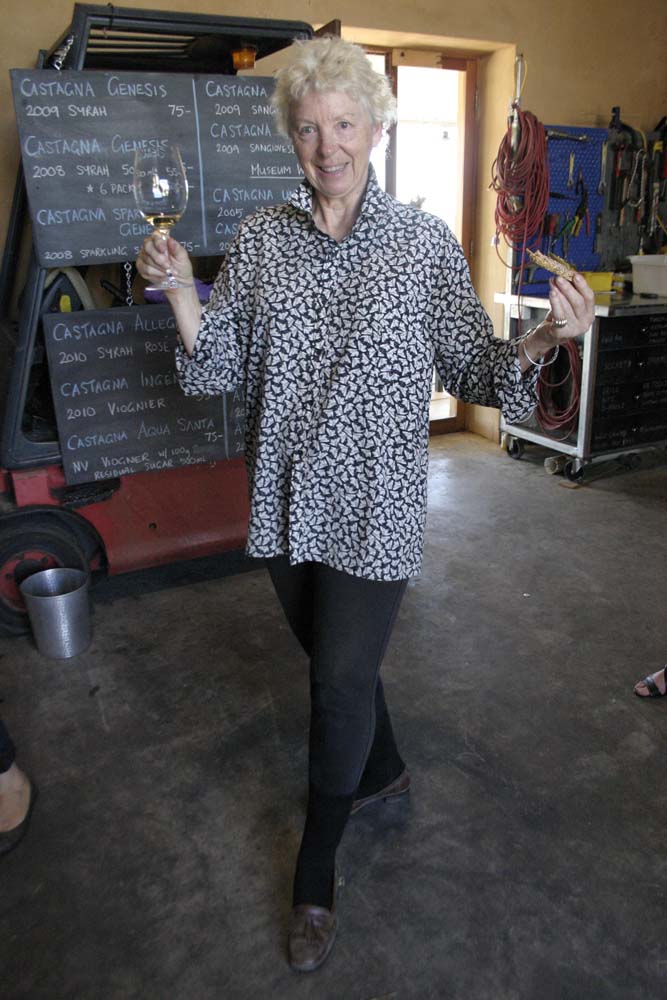Andrew Caillard MW on Castagna Wines | The Vintage Journal
In The Vintage Journal, Andrew Caillard Castagna Wines review highlights Beechworth’s biodynamic philosophy…
Julian Castagna is a unusual Australian vigneron combining artistic flair, quixotic dreams and singularity in his quest to make “wines of terroir”. After a career as a film director in London and running a production house in Sydney, he (and his wife Carolann) bought land and planted a vineyard in 1997 near Beechworth in the foothills of the Victorian Alps.
Undaunted by his lack of technical training, he paved his own pathway. Counterintuitively Castagna stepped into the world of biodynamic viticulture before sustainability and circularity became fashionable and necessary. His enthusiastic ambition for growing and making “old world wines with new world fruit”, were probably naïve, but he soon became a leading proponent of biodynamic viticulture in Australia.
His alternative views, quirky personality and distinctive wines led to a loyal following and interest. It takes a great amount of personal belief and hard work to create momentum in the world of fine wine. A science degree or course in agriculture, viticulture or winemaking helps. But experience making films is probably a good start too. Having seen film directors at work, there are many similarities to making wine. Ultimately it is organizing chaos and creating a story-arc that captures the imagination. It takes some chutzpah to build something unique, especially when everything is connected to the authenticity and voice of vineyard site.
The romance of 19th Century vinestock and Italian heritage are integral to the Castagna story. It is a theme that many other small wineries use or should use, because vinestock transmission, breeding and selection have played a crucial part in Australia’s fine wine agenda. Of particular interest is Julian Castagna’s block of sangiovese vines. Although the variety was brought into Australia during the 19th Century (notably by Dr Fiaschi of Tizzana Winery in the late 1880s), it did not take off in any meaningful way.
The Grape and the growers Italian Heritage…
At this time Australian Burgundy and Claret styles dominated the market. After 1924 the fortified market also gathered steam. But an interest in Italian grape varieties began to return during the 1980s. With an Italian heritage of his own, Julian Castagna was keen to dabble with Italian varieties. By chance he discovered an old vine growing in the backyard of family friends at Myrtleford in Victoria.
During the 1920s many Italian migrants arrived in the area to grow tobacco or work on farms. Some of them brought vine cuttings, perhaps with the idea of making their own wine. According to Castagna this particular vine was brought from Montalcino, Tuscany in 1922. He said “The grapes had a very high level of pips and not very good for eating. They were very happy to let me take cuttings.” If the provenance is correct, Castagna’s small block of sangiovese vines are directly related to the prized Brunello di Montalcino; hence the sangiovese-grosso reference. Having researched many stories in recent years, this particular snippet of fascination is probably true. For instance, this story parallels the discovery of Semillon in a Pyrmont garden by Thomas Shepherd over 100 years earlier.
The elevated 50-acre Castagna vineyard (on decomposed granitic loam over clay) is small by Australian standards and produces about 2600 cases a year. The winery’s reputation is hinged on red wines and this is probably to do with the cult wine scene that was emerging during Castagna’s first decade of production. I know he dabbled with exporting his wines through Grateful Palate to the US, but the wines were never really suited to the American cult persuasion for syrupy alcoholic wines. Over the last twenty years Castagna settled into the pace of life at Beechworth and has built-up a solid following for his wines. For instance, the Castagna Genesis Shiraz is included in Langton’s Classification of Australian Wine. This is an endorsement of its collectability, cellaring endurance and reliability.
There is a distinct garrigue-like scent in Castagna’s wines and the textures have a lovely refined bitterness, the type found in Campari or chinotto. These characters seem to give lift and torque. The white wines, especially the chardonnay, are exemplary. The chenin blanc was of particular interest because of its potential and connection with the Loire. Castagna “worked closely” with biodynamic pioneer Nicholas Joly in his quest to farm sustainably and to make wines from living soils. A waxy complexity is just beginning to emerge.
With a few years of bottle age this could become something quite special. Castagna Genesis Syrah is captivating and delicious but the stand-out is the 2017 La Chiave Sangiovese. It is a reference example and even with a good four years of bottle-age it shows great potential. There is a very attractive authenticity about these wines which has no doubt played a part in Julian Castagna playing an important role in building up the fine wine credentials of the Beechworth wine region.
Castagna Wines, Beechworth – Northeast Victoria:
2019 Castagna Allegro Rosé, Beechworth – Northeast Victoria
Pale salmon. Fragrant red cherry, raspberry, onion skin and hint of marzipan aromas. Generous red cherry, raspberry, flinty, tonic water flavours, fine bitter/ al dente textures, attractive mid-palate viscosity and fresh crisp acidity. Lovely fruit complexity and mineral length. Based primarily on syrah and a touch of viognier. Ready to drink. 13.5% alc **93 points**
2018 Castagna Grower’s Selection Chardonnay, Beechworth – Northeast Victoria
Medium pale colour. Fresh apricot, peach, grapefruit aromas with tonic water, flinty notes. Generous and supple with ripe stone fruits, cashew nut flavours, some crème brulée/ butterscotch notes, vanilla al-dente textures and integrated fresh acidity. Creamy and complex wine with lovely freshness and torque. Idiosyncratic and classical at the same time. 20% Estate grown; 30% new French oak. Ready to drink. 13.5% **93 points**
2019 Castagna Grower’s Selection Chardonnay, Beechworth – Northeast Victoria
Medium pale colour. Intense lime, grapefruit, lemon curd aromas with flinty, cashew nut notes. Lovely grapefruit, stone fruit, lime flavours, underlying grilled nut notes, fine loose knit chalky, hint graphite textures, attractive mid-palate viscosity and fresh mineral acidity. Very classical in style with sotto voce alcohol allowing the mineral characters to persist. 12.5% alc **94 points**
2019 Castagna Chenin Blanc, Beechworth – Northeast Victoria
Pale gold. Fresh fragrant, honeysuckle, herb garden, lemon curd aromas with waxy notes. Pure lemon curd, honey flavours, with underlying grilled nut complexity, fine bitter textures and fresh long acidity. The waxy complexity is just coming through. This is a very impressive Australian Chenin Blanc. Cellar for a few years and this will be something special. 14% alc **94 points+**
2019 Castagna Ingenue Viognier, Beechworth – Northeast Victoria
Pale yellow. Fresh apricot, lemon curd, verbena, herb garden aromas. Richly flavoured palate with attractive apricot, white peach, pearskin flavours, fine looseknit chalky/chewy textures and underlying herb notes. A pure, minerally, bittersweet finish. A very complete and controlled wine with beautiful aromatics and texture. Excellent wine. 14.5% alc **95 points**
2017 Castagna Segreto, Beechworth – Northeast Victoria
Medium deep crimson. Attractive red cherry, redcurrant, blackberry, sweet paneforte aromas with vanilla notes/ herb garden notes. Generous and chocolaty textured with plentiful red and black cherry, blackberry, satsuma plum fruits, brambly textures and underlying chinotto notes. Finishes firm with sustained and evolved sweet fruits. Lovely to drink now. Sangiovese, Syrah, Viognier blend. 14.2 % alc **94 points**
2017 Castagna La Chiave, Beechworth – Northeast Victoria
Medium deep crimson. Beautiful dark cherry, dark plum, amaro, Campari aromas with lifted graphite notes. Richly flavoured and voluminous palate with deep set dark cherry, musky plum, praline flavours, integrated savoury oak, fine bittersweet tannins and some leafy notes. Finishes claret firm. Lovely concentration, character and vinosity. Roughly 20% new French oak. 100% Sangiovese 14% alc **96 points**
2004 Castagna La Chiave (sangiovese), Beechworth – Northeast Victoria
Rather gorgeous wine with intense, complex black and redcurrant, polished leather, roasted chestnut, meaty aromas with aniseed, black liquorice notes. Voluminous and animated palate with deep set dark chocolate, dark berry fruits, roasted chestnut notes, plentiful fine chocolaty textures. Still vigorous with chalky firm finish. Lovely extract and density. Tasted from magnum. 100% Sangiovese. 14% alc? **96 points**
2017 Castagna Genesis (syrah/viognier), Beechworth – Northeast Victoria
Deep colour. Classic dark chocolate, dark berry, wood varnish stone fruit aromas. Generous decadent wine with ample black cherry, dark chocolate flavours, brambly textures, fine cedar notes, underlying savoury notes and fresh long acidity. Finishes firm with a chalky tannin plume. Syrah Viognier. 14% alc **95 points**



